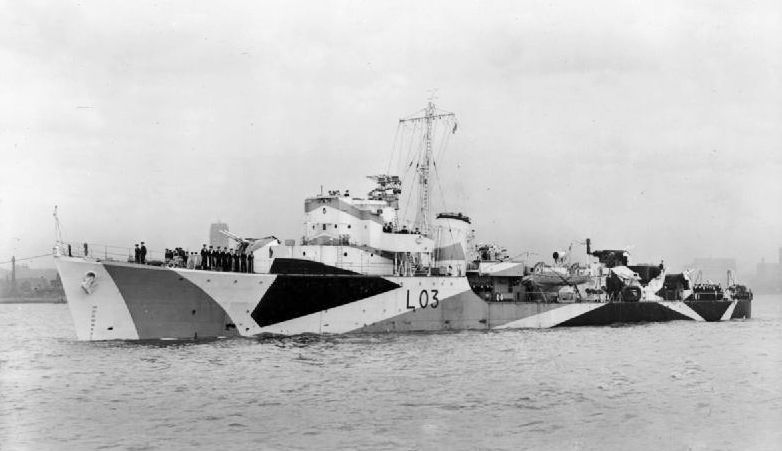NYC Fireboat Rebranded in Vibrant Dazzle Camouflage to Commemorate WWI
Vessels cloaked in clashing colors, patterns attempted to confuse U-boat commanders by distorting their perception of a ship’s speed, size and location
/https://tf-cmsv2-smithsonianmag-media.s3.amazonaws.com/filer/45/4f/454f7463-689b-42d3-a249-1a05099e6de6/image-by-nicholas-knight-courtesy-public-art-fund-680x453.jpg)
This summer, visitors to New York Harbor may encounter an unusual sight: fireboat John J. Harvey, newly cloaked in red-and-white patterns evocative of a candy cane.
The historic ship, which first docked in the city in 1931 and is now a museum and education center, is one of five boats featured in a centenary World War I initiative co-sponsored by the Public Art Fund and British-based organization 14-18 NOW. Hyperallergic’s Allison Meier reports that the reimagined vessel is the brainchild of American artist Tauba Auerbach, who is calling the paint job "Flow Separation." The boat, as well as boats docked in London, Liverpool and Leith, Scotland, commemorates the wartime tradition of “dazzle camouflage,” an experimental technique designed to ward off German U-boats by assailing submarine commanders with a cacophony of clashing colors.
Dazzle camouflage dates back to 1917. In February of that year, Germany’s Kaiser Wilhelm II authorized the use of unrestricted U-boat warfare against neutral and enemy ships alike. The switch from targeted torpedoing to indiscriminate attacks devastated the already crippled British fleet, which lost 925 ships in the span of just 10 months, and brought World War I to a critical point.
Norman Wilkinson, a British artist and illustrator who moonlighted as a Royal Navy volunteer, observed this new brand of warfare with increasing unease, Sam Willis reports for the BBC. Hoping to brainstorm a winning protective mechanism, he turned to an unlikely source of inspiration: modern art.
“Since it was impossible to paint a ship so that she could not be seen by a submarine, the extreme opposite was the answer,” Wilkinson later recounted. “In other words, to paint her, not for low visibility, but in such a way as to break up her form and thus confuse a submarine officer as the course on which she was heading.”
Wilkinson’s scheme was brilliantly counterintuitive. Instead of attempting to blend into the ocean seascape, ships would attract enemy combatants’ attention through a dizzying array of colors and shapes. These designs, ranging from alternating swaths of orange and blue to curved lines capable of simulating a ship’s bow wave, masked vessels’ “shape, size and direction,” Linda Rodriguez McRobbie writes for Smithsonian.com. By confusing U-boat commanders long enough to prevent them from accurately aiming and firing, merchant ships would, hypothetically, have enough time to fight back.

According to the BBC’s Willis, dazzle camouflage was applied to more than 2,000 ships over the course of World War I. Although the number of successful U-boat attacks fell in conjunction with the scheme’s implementation, it’s unclear how much of an impact dazzle actually had, as additional countermeasures were instituted around the same time.
Roy Behrens, a professor at the University of Northern Iowa and the author of several works on dazzle camouflage, tells McRobbie that a September 1918 Admiralty report reached inconclusive results. In the first quarter of the year, 72 percent of dazzled ships attacked by U-boats sunk or experienced significant damage, while 62 percent of non-dazzled ships sank or were damaged. In the second quarter, these figures switched: 60 percent of attacks on dazzled ships resulted in sinking or damage, as opposed to 68 percent of non-dazzled ships.
In 2016, researchers at the University of Bristol found that dazzle camouflage had a measurable influence on a target’s perceived speed, enabling targets to simulate faster or slower movement based on the direction of their camouflage pattern. This research built on a 2011 Bristol study that suggested camouflage can affect speed perception, but only if the target is moving quickly.
By World War II, dazzle camouflage had fallen out of favor with the British Admiralty, replaced by the accurate mapping of radar technology. Although British merchant ships operating during World War I were unable to reach high enough speeds for the dazzle to work properly, the unconventional technique holds a unique place in military history. In addition to boosting morale amongst dazzle ship crews, the designs reportedly impressed cubist master Pablo Picasso, who, upon seeing a Parisian tank painted in a dazzle pattern, exclaimed, “It is us who created that.”
And while dazzle camouflage hasn't been seen in warfare in recent years, Nick Scott-Samuel, a professor of visual perception at Bristol who co-authored the 2016 dazzle study, tells Willis the technique could have applications in modern warfare.
“In a typical situation involving an attack on a Land Rover, the reduction in perceived speed would be sufficient to make the grenade miss by about a metre,” Scott-Samuel explains. “This could be the difference between survival or otherwise.”
Like the World War I vessels it commemorates, John J. Harvey's dazzle paint attempts to fool the eye, making it hard to tell which direction the boat is moving.
Auerbach used a process known as marbling to generate “these kinds of patterns with fluid dynamics,” project curator Emma Enderby tells Meier.
“Her design was very much influenced by the fact that this was a fireboat, so it has water moving through the body of the boat as well, and that was her way into the project … thinking of that movement of water,” Enderby explains.
Although it currently stands out amongst the fleet at New York Harbor, come May 2019, the fireboat will return to its original dazzle-free exterior, mirroring the Allied vessels’ post-war reversal from chaotic color to somber gray.
“Flow Separation” is on view at Brooklyn Bridge Park’s Pier 6, Hudson River Park’s Pier 25 Hudson River Park’s Pier 66a through May 2019. Visit on the weekend to enjoy a free voyage, or stop by on a weekday to explore the ship’s deck.
/https://tf-cmsv2-smithsonianmag-media.s3.amazonaws.com/accounts/headshot/mellon.png)
/https://tf-cmsv2-smithsonianmag-media.s3.amazonaws.com/accounts/headshot/mellon.png)